24 May 2024
Global Market Outlook
Global Market Outlook
A macro summer
We see room for equity market gains to extend as cooling inflation brings bond yields lower and sustains central bank rate cut expectations for the rest of the year. We remain Overweight equities in Foundation allocations.
Within this, we maintain our preference for US and Japan equities and EM USD bonds. We remain reluctant to chase Gold higher, given crowded investor positions.
In Opportunistic allocations, we add Buy ideas on Taiwan equities and China USD bonds and close US energy sector equity and US inflation-protected bond Buy ideas.
Can China’s stock market rally sustain?
What are the drivers of the opportunistic Buy ideas?
What is the signal from the quantitative models?
Strategy
Investment strategy and key themes
|
|
||||
|

Our top preferences
Foundation Allocations
- OW Global equities
- In equities: US, Japan
- In bonds: EM USD bonds
Opportunistic Allocations
Equity BUY ideas
- US technology sector
- US comms. services sector
- Europe energy sector
- India large cap equities
- China non-financial divi SOEs
- South Korean equities
- Taiwan large-cap equities
Bond BUY ideas
- Europe govt. bonds (FX-hedged)
- INR local currency bonds
- China USD bonds
FX views
- Rangebound USD
A macro summer
- We see room for equity market gains to extend as cooling inflation brings bond yields lower and sustains central bank rate cut expectations for the rest of the year. We remain Overweight equities in Foundation allocations.
- Within this, we maintain our preference for US and Japan equities and EM USD bonds. We are reluctant to chase Gold higher, given crowded investor positions.
- In Opportunistic allocations, we add Buy ideas on Taiwan equities and China USD bonds and close US energy sector equity and US inflation-protected bond ideas.
A post-inflationary sigh of relief
A macro data-led month. After several higher-than-expected US inflation readings, markets appeared to collectively heave a sigh of relief that the latest US CPI inflation readings were slightly below expectations. April’s pullback in US stocks was correlated with a jump in inflation worries, which led to a pushing back of Fed rate cut expectations and a rise in US bond yields.
This relatively high correlation with the macro data extended into May, with the rebound in equities and bonds correlating closely with a fall in US inflation surprises. This was consistent with our own expectations that the pullback in equities and bonds was likely to be temporary. In May month-to-date, global equities have risen 4.3%, while global bonds have gained 1.3%.
We see room for equity and bond market gains to extend. Several indicators of the US housing market, especially falling market rental costs, suggest it is reasonable to expect official inflation to continue grinding gradually lower. This, in turn, should help the market’s inflation expectations and bond yields to ease and the Fed to start cutting rates in H2. In the Euro area, inflation remains less of a challenge. As a result, we continue to see room for the ECB to start cutting rates in June, ahead of the Fed, given the region faces more growth than inflation challenges. Both these trends, we believe, mean the policy backdrop remains a positive one for global stocks and bonds.
Fig. 1 Volatility has declined across asset classes as inflation starts to subside once again
Equity (VIX), Bond (MOVE) and FX (CIVX) volatility
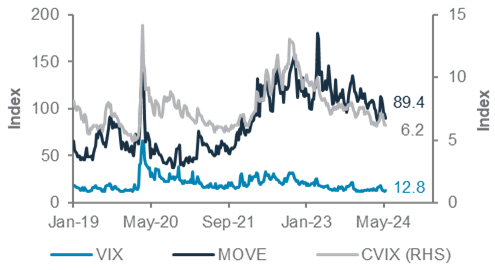
Chase the rally?
Although the equity market pullback is behind us, is the rebound sustainable? We believe the answer is yes.
In US equities, our short-term (1-3m) technical model remains positive, led by strong momentum and low volatility. This model did well in assessing that last month’s pullback was temporary. Our long-term (6m) fundamental model remains positive as well, albeit less so than a month ago following soft labour market data. Together, we believe the case to remain Overweight equities, and, the US within that, remains intact.
What about ‘Sell-in-May’ seasonality? We would not reduce exposure on seasonality alone. The current backdrop of softening inflation, a still-robust economy, a strong Q1 earnings season and supportive technical indicators makes a pullback unlikely in the short term without an external shock. Our view of a US economic soft landing means that we would not worry excessively about slowing growth unless the labour market starts to weaken significantly.
Japan remains the only major market where our short-term technical model remains bearish. Nevertheless, we continue to see this as an opportunity to accumulate given our long-term view of improving growth and shareholder-friendly policies causing us to retain an Overweight view.
In Asia, it is fair to question whether China’s issuance of special ultra-long government bonds and a proposal to buy unsold real estate inventory signal a turning point in the market’s outlook. We hold a balanced view. Short-term market momentum remains strong, arguing for further gains over 1-3 months. Longer term, though, we do not see the announced measures as being significant enough to alter our core holding view on China equities relative to Asia ex-Japan.
Indian equities have also rebounded in recent weeks as Parliamentary elections come towards a close on 1 June (results due on 4 June). Expectations for policy continuity remain high, and history shows markets trend positively into elections and react well to expected outcomes. We remain Overweight Indian equities within Asia ex-Japan.
Fig. 2 US inflation has started to ease again, which should help sustain the equity market rebound
US inflation surprise index vs. S&P500 m/m
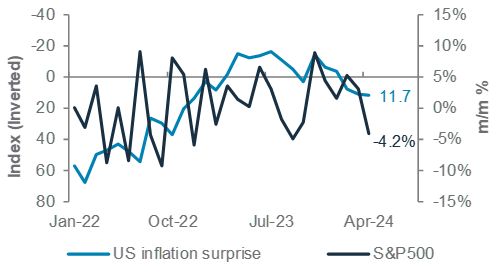
Buy ideas – adding Taiwan, closing US energy
We make four changes to our opportunistic ideas this month.
First, we add a new Buy idea on large-cap Taiwan equities. The market’s significant exposure to the semi-conductor sector means it is likely to benefit from demand for its most advanced chips from both AI and non-AI users.
Second, we are adding a new Buy idea on China offshore USD bonds. While riskier Asia USD bonds have rallied and credit spreads generally remain tight across most corporate and EM bonds globally, China USD bonds still offer some value, in our assessment.
Third, we are closing our Buy idea on the US energy sector, following a 2.2% loss since we initiated the Buy idea on 27 March 2024. This closure will help trim our energy exposure as oil prices come off the boil. However, our Buy on European energy sector remains open. This should benefit from strong free cash flows and high dividend and share buyback yields from integrated oil companies, besides offering a hedge against the risk of any new oil price surges.
Fourth, we are closing our Buy idea on US inflation-protected bonds as inflation worries start to recede. Although the idea is down slightly (-0.9% since inception on 1 February 2024), it has outperformed the broader global bonds asset class by 2.1% as inflation concerns escalated in Q1.
What about gold and bonds?
Gold continues to rise, with the current rally likely driven by strong end-user demand, central bank demand and, more recently, by easing US bond yields. However, investor positioning looks crowded. While we revise our 3-month price expectation modestly higher (see page 14), we continue to believe a core allocation (around 5% allocation across most risk profiles) offers the best risk/reward at current levels.
Within bonds, EM USD bonds have outperformed global bonds so far in Q2, with support from high yields and the asset class’s high sensitivity to falling US bond yields. We retain our Overweight on EM USD bonds, expecting these factors to continue to offer support.
Foundation asset allocation models
The Foundation and Foundation+ models are allocations that you can use as the starting point for building a diversified investment portfolio. The Foundation model showcases a set of allocations focusing on traditional asset classes that are accessible to most investors, while the Foundation+ model includes allocations to private assets that may be accessible to investors in some jurisdictions, but not others.
Fig. 3 Foundation asset allocation for a balanced risk profile

Fig. 4 Foundation+ asset allocation for a balanced risk profile
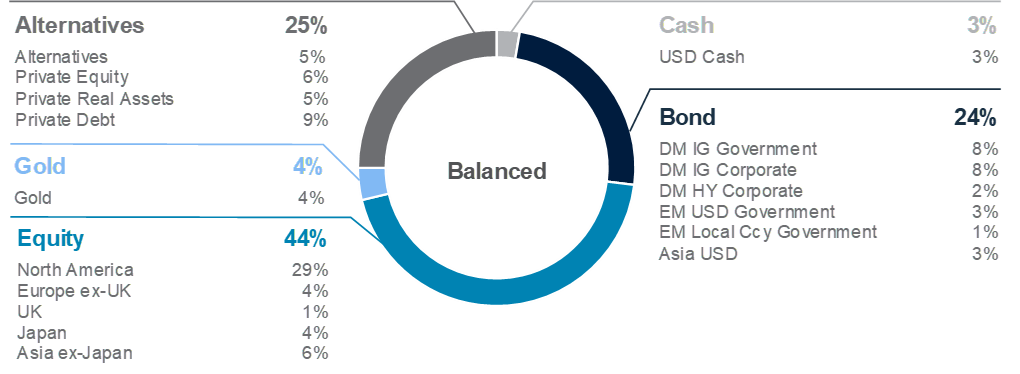
Fig. 5 Multi-asset income allocation for a moderate risk profile

Foundation: Our tactical asset allocation views
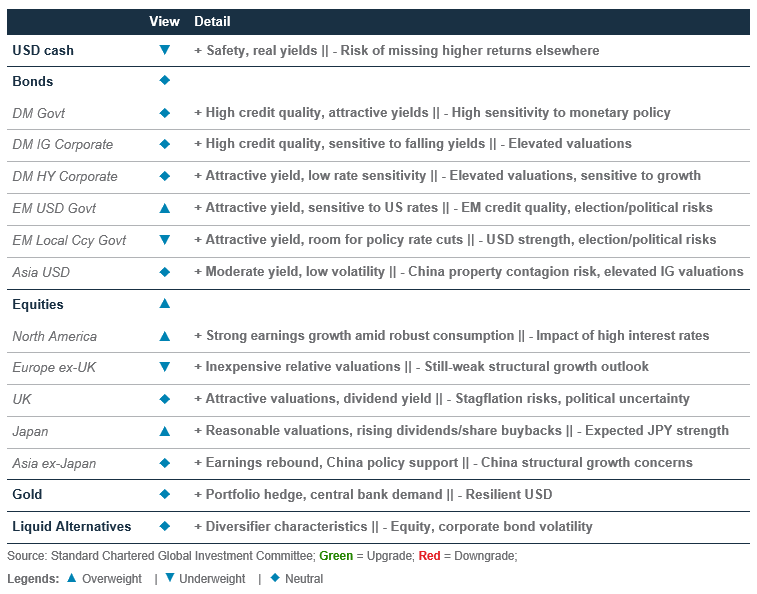
Fig. 6 Performance of our Foundation Allocations*
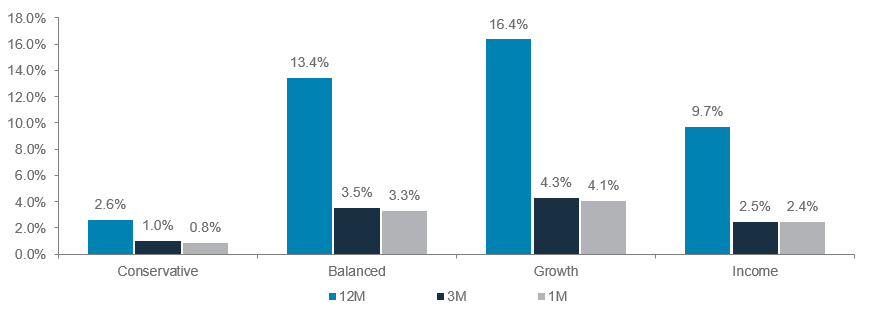
*12-month performance data from 23 May 2023 to 23 May 2024, 3-month performance from 23 February 2024 to 23 May 2024, 1-month performance from 23 April 2024 to 23 May 2024.
Perspectives on key client questions
|
|
||||
Can China’s stock rally sustain?
Mainland China and Hong Kong stocks have taken off in 2024 after spending three years in the doldrums. In 2022 and 2023, the MSCI China index was among the world’s worst-performing stock indices. Year-to-date, however, it has outperformed the US’s S&P500 index. Investor optimism can be attributed to a string of measures introduced by the authorities to support the stock and property markets, while cheap valuations have also spurred foreign investor rotation from US and Japan stocks. Nevertheless, the economic recovery in China continues to be patchy, with no end in sight to the property sector’s woes.
Can China and Hong Kong stocks build on the recent optimism to rally further, despite still lacklustre economic fundamentals? We dug deeper to examine the factors driving this stock market rebound and came to the following conclusions:
- A stabilisation in economic activity and improvements in earnings expectations are required for a sustainable rally in equities. The good news is, at least, earnings expectations have been showing signs of stabilisation of late.
- Investor positions are no longer as bearish and valuations have normalised, and much of the positioning-related gains in the stock market may already be over.
- However, momentum continues to be strong, and the simple strategy of ‘letting your winners run and cutting your losses short’ has proven to be profitable for investors in the Hang Seng index.
Better economic and corporate fundamentals are crucial for further returns
Economic and corporate fundamentals are crucial for equity performance, as annual gains in equities track economic activity and earnings revision (See Fig 7). However, economic drivers remain lacklustre. While there has been some improvement in the inflation trend, credit growth has weakened, household consumption has slowed, and inward FDI flows have flatlined – a reflection of the macro and geopolitical climate. The property sector remains a drag, and while recent measures, which include instructions for local governments to buy unsold housing inventories, could help on the margin, their effectiveness in boosting sales and stemming the slide in demand is debatable. Until such measures prove successful in arresting the slump in the property sector and lifting the overall economy, a longer-term sustainable rally

Fig. 7 Annual gains in the MSCI China index have tracked economic activity and earnings revision indices closely
Li Keqiang index vs MSCI China* (LKQ index as of Mar 2024)
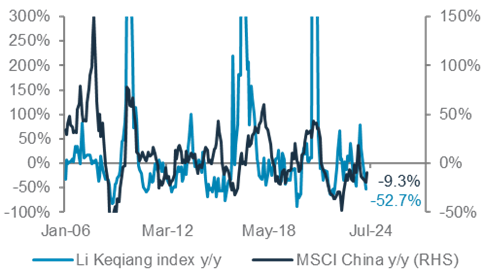
Earnings revision index vs MSCI China
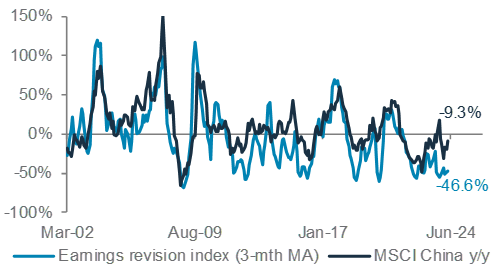
Source: Bloomberg, Standard Chartered. As of April 2024. *Le Keqiang index is an economic measure created by The Economist as a higher frequency growth indicator proxy for China. It is composed of railway cargo volume, electricity consumption and loans disbursed by banks.
could remain elusive. The good news is, at least, earnings revisions have been showing signs of stabilisation of late. Corporate fundamentals have been on the mend despite the challenging economic climate, with an increasing number of companies beating earnings estimates for the second straight quarter in Q1. Further stabilisation in the earnings revision index thus bodes well for added stock market performance and may be indicative of an eventual improvement in economic fundamentals as well.
Valuations have normalised and investor positioning is no longer as bearish
While economic and corporate fundamentals are better predictors of the stock market’s longer-term performance, positioning and momentum provide more useful insights as to whether the recent rally can continue in the near term. This is crucial, as valuations have now normalised. This means foreign investor rotation away from the US and Japan in search of cheaper valuations in China may start to slow. (See Fig 8)
Fig. 8 China stock valuations have normalised against EM ex-China stocks and are no longer as cheap vs Developed Market (DM) stocks
MSCI China’s relative valuation vs MSCI EM ex-China and MSCI World* indices
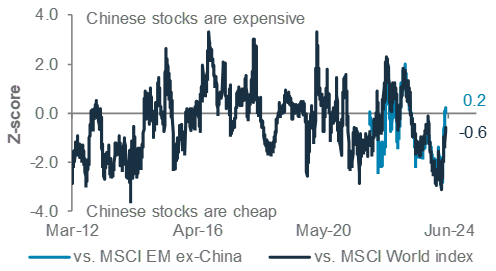
Meanwhile, a look into investor positions also reveals that investors have now turned bullish. At extreme levels, this is typically a contrarian signal for stock market performance. The bullish turn in positioning is also concerning when considering that since peak bearish positioning was reached in China A shares on the 23 January, the CSI 300 index has already gone on to rally almost 14%. This could mean that much of the positioning-led gains may already be over, given that 12-month forward returns based on current positioning are now more likely to be negative than positive. (See Fig 9)
Do not fight the momentum and let your winners run
While the stock market has run ahead of economic fundamentals and valuations and investor positions have turned less supportive, momentum, however, remains strong. A simple strategy of “letting your winners run and cutting your losses short” has proven to be profitable for investors in
Fig. 9 12-month forward returns have typically been opposite to extreme investor positioning
12-month forward returns and investor positioning*
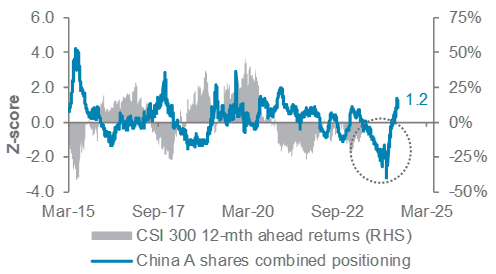
the Hang Seng index (HSI). By going long when the 30-day rolling returns exceed 20%, and closing your position when the 20-day rolling returns fall below -8%, investors can achieve an average return per trade of 8.8%, with a hit rate of 80%. For investors, instead of taking profits prematurely in the face of strong price momentum, it may thus pay to closely track price actions and only take profit on positions when momentum falters based on our close signal and the market turns decisively lower. (See Fig 10)
Still a long road to recovery; stay neutral on China equities
The recent rally in China’s stock market has triggered a “fear-of-missing-out,” and investors may be tempted to chase the rally, especially after several years of lacklustre performance. However, the economy’s road to recovery remains long, and some of the drivers of the recent stock market gains have also turned less supportive. Investors should thus continue to exercise caution and balance the recent positive property sector developments and strong price momentum with the still uncertain outlook ahead. Until there are further evidence that economic and corporate fundamentals are on a definitive uptrend, we will continue to recommend a neutral (core holding) allocation to China within our Asia ex-Japan equities.
Fig. 10 Going long when 30-day returns exceed 20% and closing when 20-day returns fall below -8% is a simple strategy that has proven to be profitable
The Hang Seng index with buy and sell signals
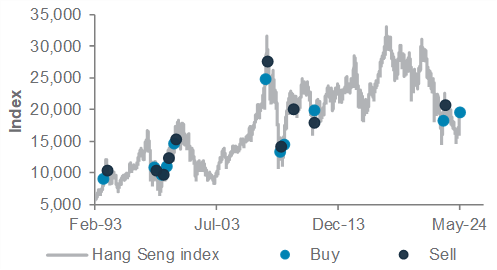
Macro overview – at a glance
Our macroeconomic outlook and key questions
|
Key themes
Return to ‘soft-landing’: After a growth and inflation spurt in Q1, the global economy appears to be heading towards a soft-landing. Most US indicators of consumer and industrial activity for April fell short of expectations, while the job market continued to cool. We expect a burst of immigration over the past year to alleviate worker shortages, sustain the consumption-driven growth, while keeping wage pressures subdued. The Euro area and China are benefitting from a revival in global trade. China is starting to address the property-sector slump, although it needs to do more to revive consumer and business confidence.
US cooling again: US inflation resumed its downtrend in April after a spurt in Q1, with auto insurance and medical service inflation slowing. While shelter inflation remains high, we expect the official data to catch up with cooling market rents in H2. Euro area inflation continues to slow, while China continues to struggle with an overhang in the property market.
ECB to cut before the Fed: We expect the ECB to start cutting rates in June as inflation slows towards its 2% target. The Fed is likely to follow with a total 50bps of cuts in H2 once policymakers ensure that April’s downtrend in inflation sustains for a few more months. China is likely to ease bank reserve requirements and cut rates in H2 to support growth.
Key chart
Most US economic activity indicators for April have missed estimates after Q1’s burst, enabling inflation to cool once again; Europe and China are benefitting from a revival in global trade, while China takes steps to reduce its property sector glut
Fig. 11 US economy cooling; Euro area and China benefitting from global trade spurt
Economic surprise indices; US headline, core and supercore* inflation, 1-month annualised

Macro factors to watch
US economy cooling. A series of weaker-than-expected economic indicators for April suggest the US economy is finally cooling down this year after last year’s above-trend growth. This is also reflected in the job market, where the job openings rate fell to a 3-year low. The slowdown was long expected, given the lagged impact of 23-year high policy rates, tightening bank lending conditions and a negative fiscal impulse. According to the San Francisco Fed, US households have run down their excess savings, which have been sustaining consumption in the post-pandemic period. While a burst of immigration is sustaining overall consumption, it is also helping to reduce wage pressures. Meanwhile, we expect some of the lagged components of official US inflation data, notably auto insurance and shelter, to catch up with cooling market prices in H2. An environment of slowing growth and sustained decline in inflation (a few months of 0.2% m/m of core inflation) is likely to create conditions for the Fed to cut rates by a total 50bps in H2 as it shifts its focus towards supporting growth.
ECB to cut rates in June. Euro area inflation continues to slow faster than US inflation as tight lending conditions and record high policy rates keep growth close to stagnation. Although the region emerged in Q1 out of last year’s technical recession on the back of a revival in global trade, fiscal spending and rising disposable income, Germany, the region’s largest, remains a drag as it deals with challenges from higher energy costs and green transition. We believe sustained disinflation has set the stage for the ECB to start cutting rates in June, with a total 75bps of cuts likely this year.
China addressing property glut. China’s economy is losing momentum in Q2, despite several rounds of monetary and targeted fiscal easing. Credit growth slowed and money supply (M1) contracted in April. Authorities have started to address the key drag, the real estate glut, by easing buying restrictions and mortgage rules. The plan to expedite ultra-long-term bond sales and local government bond issuance should support infrastructure spending. However, it may need to do more to lower the property overhang. We expect rate cuts and easing of bank reserve requirements in H2.
Asset Classes
Bonds – at a glance
|
|
||||
Key themes
We maintain a Neutral view on Developed Market (DM) Investment Grade (IG) government bonds. The softer-than-expected US April inflation data has alleviated concerns about the Fed being unable to cut rates this year. We adjust our 3-month expectation for US 10-year government bond yield to 4.25-4.50%, while keeping our 12-month view unchanged at 4%.
Within Emerging Markets (EM), we continue to favour EM USD government bonds, maintaining an Overweight allocation. We find their relative value attractive compared with similarly-rated DM peers, after the re-inclusion of a distressed sovereign issuer in benchmark indices. However, we maintain an Underweight view on EM local currency (LCY) government bonds. While EM currencies should benefit from a weakening bias in the USD in the next 6-12 months, near-term FX volatility risks persist. The yield is unattractive, in our view, particularly as major EM central banks adopt a ‘wait and see’ approach until the Fed cuts rates.
Our stance remains Neutral on both DM IG and High Yield (HY) corporate bonds. US Q1 corporate earnings released thus far have generally been solid among IG issuers, providing a backdrop for IG bond yield premiums to stay tight. However, this argument does not hold as strongly for HY issues, which continue to see rating downgrades outpacing upgrades. In Asia, we are Neutral Asia USD bonds due to a mixed economic backdrop across the region. China’s latest round of policy support for the real estate sector and the reduction of idiosyncratic risks in several volatile sovereign bond markets mean we maintain our preference for Asia HY over Asia IG bonds.
Key chart
EM USD government bonds offer an attractive pick-up in yield premiums relative to other risky credit. Improving fundamentals in DM IG corporate issuers support a tight bond yield premium, in our view
Fig. 12 Relative value of EM USD government bonds is attractive, in our view; DM IG corporate fundamentals remain strong
JPMorgan EM Bond Index spread minus Bloomberg US HY OAS index; US IG and HY upgrade/ downgrade ratio (>1 represents upgrade outpace downgrade, vice versa)

Changes to our buy ideas
Adding buy Chinese USD bonds idea. Over the past few weeks, there has been a notable improvement in investment sentiment towards Chinese assets, driven by increased policy support from authorities amid economic challenges. These measures include the affirmation of special government bond issuance, along with targeted industry policy stimulus. We anticipate these measures will provide a near-term boost to sentiment. A resurgence of offshore bond defaults is key risk.
Closing US inflation-protected government bonds buy idea. Expectation of sticky inflation in the US has normalised after the April inflation print. Some forward-looking inflation measures are pointing to lower inflation. The idea is closed at a loss of -0.9% since inception on 1 February 2024, although it outperformed the broader global bonds asset class by 2.1%.
Existing buy ideas
Buy EUR government bonds. Recent economic data in the Euro area continue to look sluggish. We believe the ECB could initiate its first rate cut in June, supporting the region’s government bond performance. Delay of this expectation is a key risk to this buy call.
Buy INR bonds. We continue to believe the asset class offers attractive risk-reward balance against the backdrop of the INR staying largely within a range in the next 12 months (USD/INR forecast: 84). While the recent performance from this asset class has been flat, we remain optimistic about potential capital gains from falling yields and the attractive yield on offer. Weaker-than-expected regional growth is a key risk.
Equity – at a glance
|
|
||||
|
|
||||
Key themes
We remain Overweight equities and believe they can outperform bonds and cash in a soft-landing scenario. We are Overweight US equities. US Q1 earnings have been strong, with companies enjoying strong margins. We are also Overweight Japan equities. The earnings outlook is improving, with rising trend in share buybacks and increase in dividends. We see a limited risk of significant JPY appreciation despite the end of negative interest rate policy from the Bank of Japan.
Asia ex-Japan remains a neutral (core) allocation. We are Overweight India given it is the fastest growing economy in the region, and its strong corporate RoE is offsetting elevated valuation. Korea and Taiwan are our two other Overweight positions in the region. The tailwind from semiconductor and AI themes justify the Overweight positions. We are Neutral China equities. Favourable government policies have “taken the baton” as the catalyst to keep the short-term momentum going as investor positions and cheap valuation normalise after the sharp rally since April. However, structural issues are likely to take time to resolve. We are Neutral China onshore versus offshore equities. Lastly, we are Underweight ASEAN, which is overly defensive in a growth environment.
We are Neutral UK equities. The current higher-yield environment is likely to help the value-tilted sectors in the market, despite the weakness in earnings revisions. We are Underweight Euro area equities on subdued economic environment and EPS growth.
Key chart
US equities broadening out. Earnings growth remains strong in the US and Japan
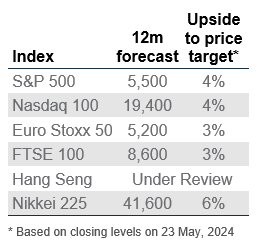
Fig. 13 Strong earnings supporting US equities. Earnings revisions are the highest in Japan and the US, our most preferred markets
MSCI US index vs 12-month forward US EPS growth. 3-month moving average of earnings revisions for various regional MSCI equity indices

US and Japan still our favourites
We believe investors should continue to Overweight the US within global equities. For Q1, 78% of the reporting companies have beaten earnings expectations, alongside positive surprises in all the sectors. We believe the US market is likely to outperform global equities due to its economic resilience and likely strong earnings growth over the next 6-12 months.
In addition, we are Overweight Japan. The market has been enjoying tailwind from improving corporate governance and increasing foreign investor inflows. Most sectors in the MSCI Japan index reported wider profit margins in the recent quarter. Besides, Japan has the highest upward earnings revision among the major equity markets at 13%. These positive factors are likely to enable Japan’s equity market to outperform broader equities.
Asia ex-Japan equities remain a Neutral (Core allocation). Valuation is no longer as cheap as before, although we still expect Asia ex-Japan to deliver the highest EPS growth in 2024 within global equities. We continue to like the strong domestic economic and structural growth trends in India and the ‘sweet spot’ that Korea and Taiwan equity markets enjoy amid strong growth in the AI and semiconductor segments.
For China equities, we see renewed signs of foreign investor inflows and supportive governmental policies. However, structural headwinds, including subdued economic growth and property sector worries, are likely to linger.
Risks to our view include stickier-than-expected inflation in the US, weaker-than-expected earnings growth in the US and Japan, a global economic downturn and any escalation in geopolitical risks.
Equity opportunistic views
|
Rotating to growth in our Opportunistic ideas
- We target positive absolute returns in our Opportunistic buy ideas. This month, we switch out of the US energy sector into Taiwan equities, keeping seven ideas in total.
Changes to our buy ideas
Closing US energy: We close this idea after almost 2 months (27 March 2024 to 23 May 2024) for a 2.2% loss. Momentum in the sector has softened in recent weeks and we take the opportunity to reduce energy exposure in our Opportunistic ideas. We remain exposed to the energy theme with our Europe energy sector equities idea.
Taiwan equities: We add Taiwan equities as a new idea. Semiconductor manufacturing has a large weight in Taiwan’s equity market. Taiwan’s market leadership in making the most advanced chips means Taiwan stands to benefit from the global AI adoption and cyclical tailwinds in non-AI demand. Taiwan’s broader economy is also likely to benefit from an export recovery in its tech sector. Weakness in semiconductor demand is a risk to the idea.
Existing buy ideas
US technology: Signs that inflation is slowing down is likely to pave the way for lower bond yields, which can sustain the valuation of Growth stocks. We expect the technology sector to benefit from strong earnings growth driven by AI spending and cloud computing. Any weakness in AI spending is a risk.
US communication services: Similarly, we expect this Growth sector to benefit from slowing US inflation. The ongoing recovery in digital advertising and the demand for online entertainment continue to support earnings momentum in the sector. A downturn in digital advertising is a risk.
Europe energy sector: The sector, dominated by integrated oil companies generating strong free cash flows, offers the highest dividend and share buyback yield in Europe. Europe’s energy sector has lagged its counterparts in the US and China year to date. A fall in the oil price is a risk.
China non-financial high dividend SOEs: We continue to see investor demand for high dividend yielding state-owned enterprises (SOEs). SOE management teams continue to have an incentive to improve their market value and we focus on non-financial SOEs due to the lack of clarity on the financial sector’s support for the distressed property sector. Adverse regulatory changes are a risk.
Fig. 14 Opportunistic buy ideas
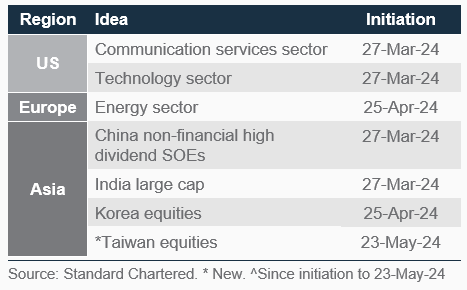
India large cap stocks: We expect policy continuity after India’s general elections, results of which will be announced on 4 June. India’s structural story of superior growth in Asia continues to be the driver of returns, in our view. A risk is weaker-than-expected growth.
Korea equities: We expect a rise in semiconductor chip prices to drive an earnings rebound in Korea, given the sector’s large weight in the market. We also expect Korea’s ‘Value-up’ programme to improve corporate governance and attract inflows as valuation remains attractive. Any weakness in memory chip prices is a risk.
Fig. 15 Our sector views by region
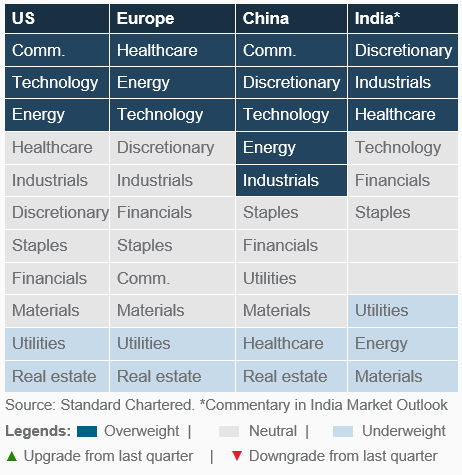
FX – at a glance
|
|
||||
Key themes
We remain modestly bullish on the USD over the next 1-3 months. While US bond yields have started to fall as inflation started to soften once again in April, we believe inflation expectations and bond yields are likely fall at a gradual pace. Bouts of geopolitical risk are also likely to trigger periodic demand for the USD as a safe haven. Together, this means that while softening bond yields are likely to cap USD gains, we expect the dollar to remain relatively resilient over the next 1-3 months. We retain our rangebound 12-month USD view, with a bearish bias. This means we expect the USD Index (DXY) at 107 in 3 months and 105 in 12 months, consistent with still-low levels of FX volatility.
We expect USD/JPY to soften to 152 on a 3-month horizon and fall further to 150 on a 12-month horizon. Rising US bond yields have helped USD/JPY to surge over the past couple of years. However, with Japanese bond yields creeping higher and US bond yields starting to soften, we believe the pair’s bias is likely to shift to the downside. Ongoing equity market inflows into Japan amid shareholder-friendly reforms are also likely to be a source of support for the JPY. A renewed rise in US bond yields or a significant rise in Japanese inflation (which, in turn, would reduce real, or inflation-adjusted, Japanese bond yields) remain key risks to our view.
We expect EUR/USD to ease to 1.05 on both 3- and 12-month horizons. Policymaker comments and falling inflation in the Euro area remain consistent with our view that the ECB is likely to cut rates in June, ahead of the Fed, putting the EUR at an yield disadvantage. This is likely to frontload a EUR pullback. GBP/USD is also likely to have a bearish bias over the next 3 months, falling to 1.21, as the Bank of England looks to ease rates to support growth. Persistent inflation is a risk to our view.
CNH weakness is likely to be capped as falling US bond yields and policy support in China offer near-term stability. We expect USD/CNH to rise modestly to 7.28 in 3-months. We remain bullish on the AUD and NZD as relatively more persistent inflation pressure limits room for their central banks to consider early rate cuts.
Key chart
Real rate differentials are supporting USD/JPY. This support may ease moderately as US yields soften over the next 1-3 months
Our revised 3-month and 12-month FX forecasts
Fig. 16 Focus remains on bond yield differentials as a key driver of USD/JPY
USD/JPY and interest rate differentials; Table of FX forecasts

A focus on key events and rate differentials
The focus on inflation and central bank reactions means FX markets continue to be closely driven by the differential in bond yields between the two sides of the currency pair. This means central bank meetings are likely to be a key focus.
One potentially key event is an ECB policy rate cut in June, putting it several months ahead of a likely Fed cut. For FX
markets, this could open a window of weakness for the EUR/USD until the Fed starts to cut as well. The GBP may also follow a similar path if the BoE is able to follow suit with a rate cut in summer. In Switzerland, the SNB has already embarked down this path, drawing away support from the CHF likely until the Fed is able to cut rates.
At the opposite extreme, Australian and New Zealand central banks do not appear to be in a hurry to cut given still-persistent inflation risks. This should prove positive for their currencies.
Gold, crude oil – at a glance
|
Key themes
We maintain a Neutral (core holding) view for gold, with a 3-month forecast of USD 2,350/oz. The yellow metal consolidated going into May, before rising to claim new all-time highs on increasing optimism about Fed’s rate cuts in H2. Safe-haven demand also remain supportive amid uncertainty in the Middle East. However, momentum seems to be slowing as it approaches stretched territory, while investor diversity remains low. Furthermore, gold ETF outflows persisted. Hence, we expect a near-term consolidation, with 2,200 being a key support. In the longer run, we expect Fed rate cuts to provide a conducive backdrop to support gold at around USD 2,325/oz. Strong central bank and physical demand also anchor the long-term outlook.
We see tight demand-supply balance favouring higher WTI oil price at around USD 83/bbl in the near term. Crude oil prices have returned to rangebound trading in May despite improving risk sentiment supported by slowing inflation and higher demand. Recent developments in the Middle East – the death of Iran’s President and the failure of Gaza conflict ceasefire negotiations – also failed to push oil prices higher. The focus is shifting to the OPEC+ June meeting, where an extension of output cuts would keep oil markets in deficit in the short run, driving prices higher. Over the longer term, potentially weaker demand on the back of slowing global growth is expected to weigh on oil prices. Moreover, elevated OPEC+ spare capacity and overly tight oil markets suggest that an increase in OPEC+ production is plausible, particularly in 2025.
Key chart
Real (inflation-adjusted) bond yields have been playing a reduced role as a driver of gold prices recently
Global crude oil supply is constrained in the near term
Fig. 17 Gold’s correlation with US 10-year real (inflation-adjusted) bond yield turned positive this year; global oil supply growth expected to slow on OPEC+ supply cuts
LHS chart: Gold price vs US 10-year real yield
RHS chart: Global oil supply growth actual/forecasts from major oil agencies

A breakdown in correlation?
Gold, a zero-yielding asset, usually has a negative correlation with real (inflation-adjusted) bond yields because its attractiveness falls as the yield on alternative assets rises. However, we saw a breakdown in this relationship recently – gold has a positive correlation with real yield this year. Similar phenomenon has occurred in the past (averaging 2 months).
Comparing with more than 40 periods of positive correlation in the past, there are two factors that could help explain the current market: 1) Central bank purchases have dominated over other macro factors in driving gold prices. This was observed in 2010/11 when central banks became net gold buyers for the first time in 20 years; 2) a higher level of uncertainty increases the allure of gold, as seen in past crises including Iraq war, Iran nuclear tensions, European debt crisis, Sino-US trade war and Russia-Ukraine war.
OPEC+ likely to extend output cuts in June
Last November, OPEC+ announced 2.2mb/d of output cuts. In March, the bloc followed up with an extension to June. In the upcoming June meeting, OPEC+ members are likely to decide on the next move. There are three possible scenarios from this meeting: 1) extend supply cuts; 2) partial unwind of supply cuts; 3) full unwind of supply cuts. We assign the lowest odds to the third scenario as OPEC+ would probably want to take a gradual approach with the unwinding of output cuts. Between the first and second scenario, we lean more towards the former due to the following reasons: 1) oil prices have been weak in recent weeks despite positive drivers; 2) fading supply risks outside of OPEC+; 3) price boost from extending the output cuts outweighs the volume hit. Consensus forecasts also expect an extension of the output cut, which is reflected in lower 2024 global supply growth estimates.
Additional perspectives
Quant perspective
Remains bullish equities; commodities stretched
|
|
||||
Summary
Long-term model remains bullish equities. Our stock-bond rotation model’s YTD excess return jumped to 3.2% compared with a 60/40 equity-bond portfolio, following the recent positive market reaction from the latest US inflation data. The model continues to Overweight equities in May, but by a smaller magnitude than last month, as the model’s score fell from +4 to +1. The drop in the model score is driven by (1) a small contraction in ISM manufacturing new orders and (2) a dip in the economic surprise index. Strong earnings revisions after the recent US earnings season have partially offset these negative shifts in economic indicators.
Short-term technical models remain bullish on most equity markets. Momentum and volatility indicators continue to be supportive of key equity markets, including China. The exception is Japan due to increased market volatility and weakening momentum indicators. Since our last outlook in April, our long positions in the US (+4.3%), Europe (+4.1%), the UK (+4.9%), Asia ex-Japan (+5.8%) and China (+8.6%) have generated strong gains, while Japan (+4.0%) has also rebounded on weakness but remains the worst performing market.
Commodities, especially copper, silver and gold look stretched on market positioning. Our proprietary indicator for investor diversity in various asset classes had previously flagged stretched positioning in gold before the precious metal lost 4.4% near the end of April. Our indicator has once again flagged a stretched positioning in gold, alongside silver and copper, as these metals have received a renewed boost from a weaker USD after the recent US inflation data.
Key chart
The valuation factor remains pro-risk despite the recent downturn in some fundamental drivers
Fig. 18 Breakdown of the stock-bond rotation model’s scores since inception in February 2023
Model scores as the sum of fundamental, valuation and market breadth factors

Fig. 19 Long- and short-term quantitative models remain bullish risky assets
Long-term models below have a typical time horizon of 3–6 months, while short-term models have 1– 3 months horizon

Today, Tomorrow and Forever

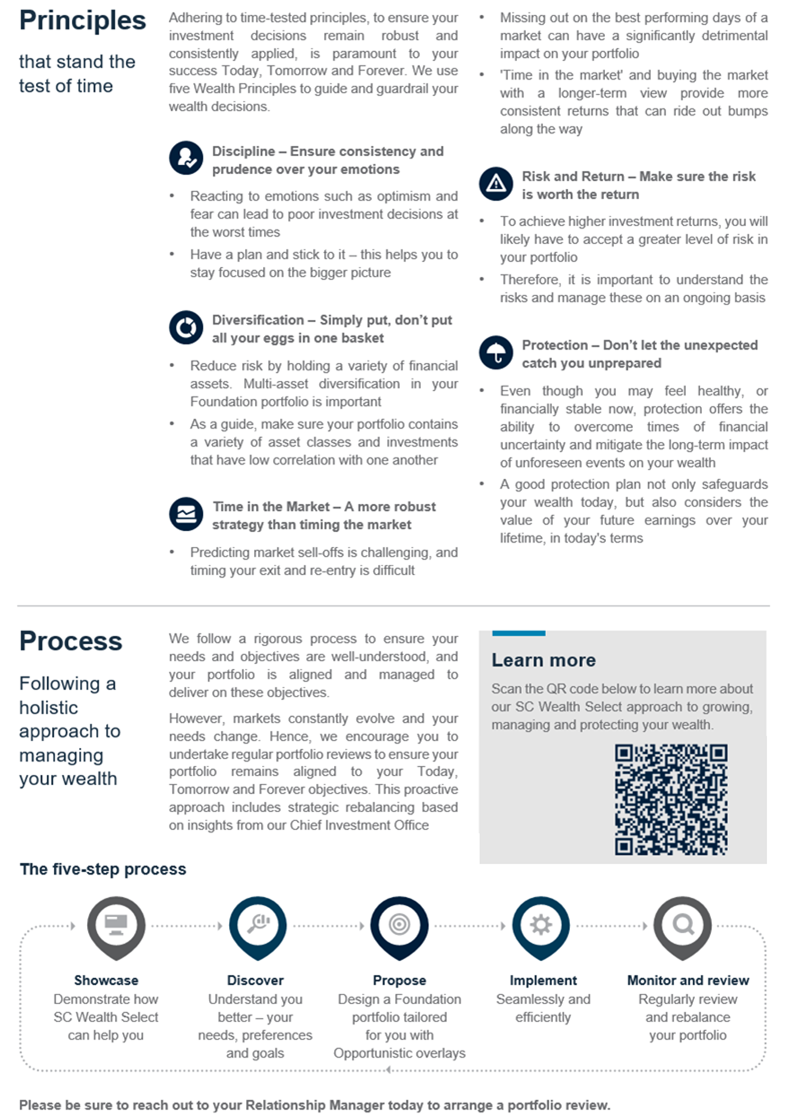
Performance Review
Foundation: Asset allocation summary
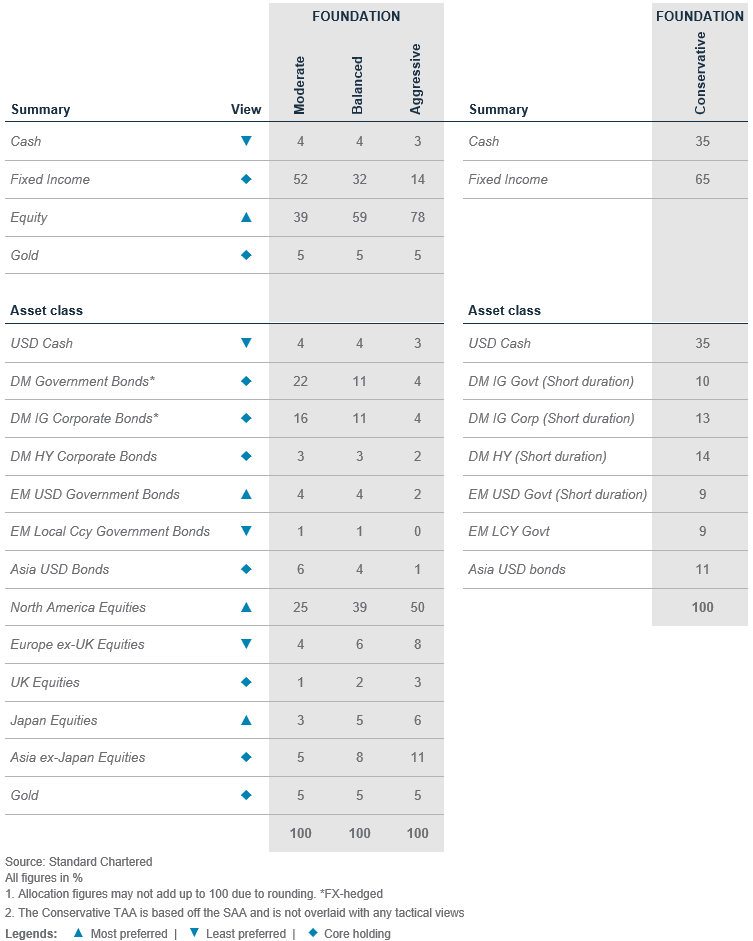
Foundation+: Asset allocation summary
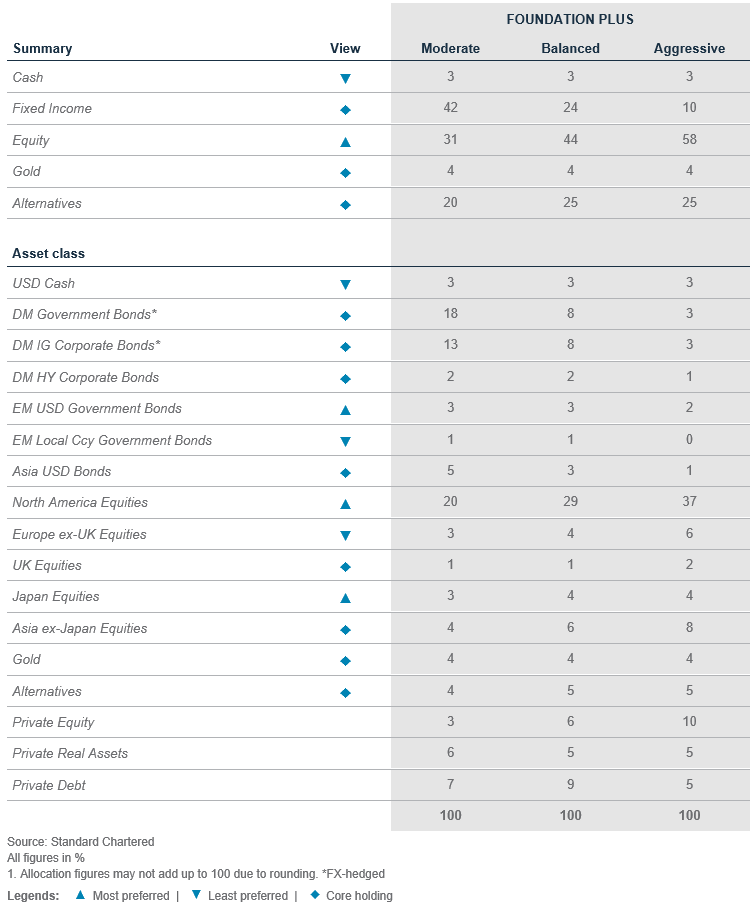
Market performance summary
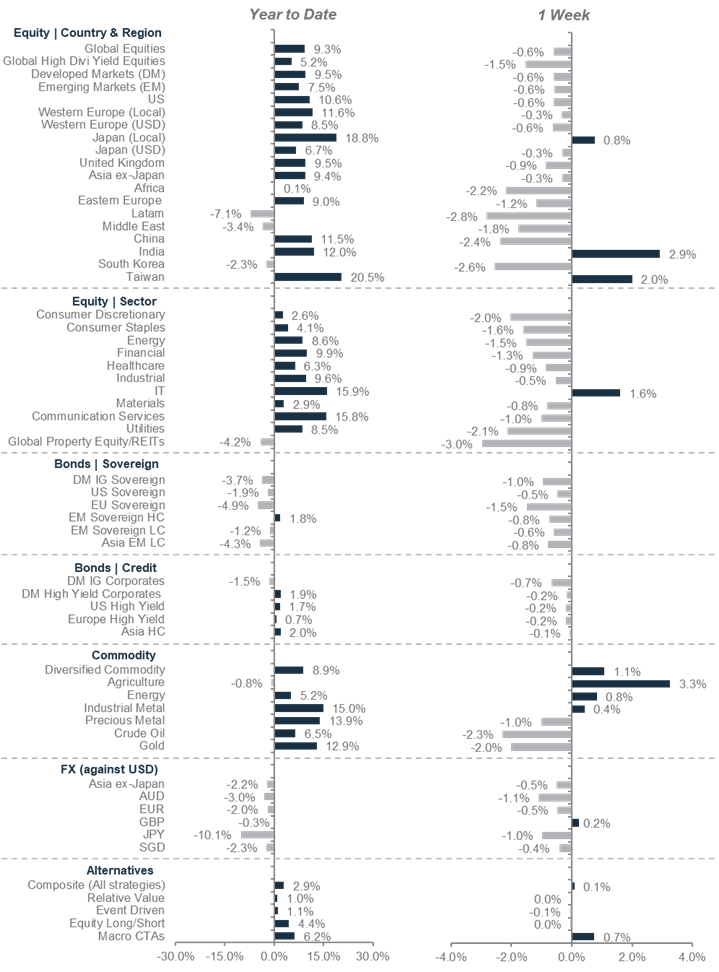
*All performance shown in USD terms, unless otherwise stated. *YTD performance data from 31 December 2023 to 23 May 2024 and 1-week performance from 16 May 2024 to 23 May 2024
Our key forecasts and calendar events

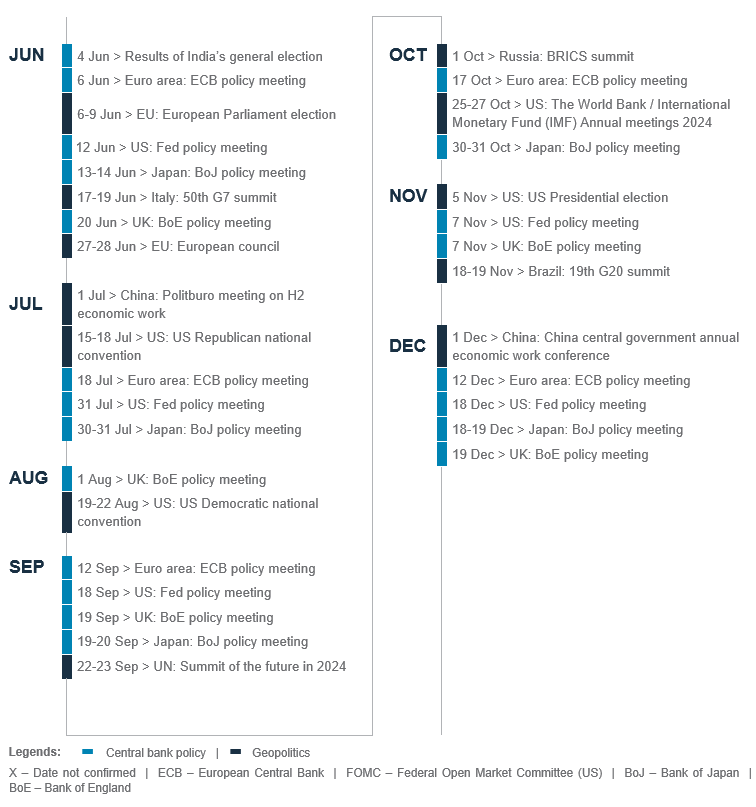
For more CIO Office insights

Explanatory notes
1. The figures on page 5 show allocations for a moderately aggressive risk profile only – different risk profiles may produce significantly different asset allocation results. Page 5 is only an example, provided for general information only and they do not constitute investment advice, an offer, recommendation or solicitation. They do not take into account the specific investment objectives, needs or risk tolerances of a particular person or class of persons and they have not been prepared for any particular person or class of persons.
2. Contingent Convertibles are complex financial instruments and are not a suitable or appropriate investment for all investors. This document is not an offer to sell or an invitation to buy any securities or any beneficial interests therein. Contingent convertible securities are not intended to be sold and should not be sold to retail clients in the European Economic Area (EEA) (each as defined in the Policy Statement on the Restrictions on the Retail Distribution of Regulatory Capital Instruments (Feedback to CP14/23 and Final Rules) (“Policy Statement”), read together with the Product Intervention (Contingent Convertible Instruments and Mutual Society Shares) Instrument 2015 (“Instrument”, and together with the Policy Statement, the “Permanent Marketing Restrictions”), which were published by the United Kingdom’s Financial Conduct Authority in June 2015), other than in circumstances that do not give rise to a contravention of the Permanent Marketing Restrictions.
Disclosure
This document is confidential and may also be privileged. If you are not the intended recipient, please destroy all copies and notify the sender immediately. This document is being distributed for general information only and is subject to the relevant disclaimers available at our Standard Chartered website under Regulatory disclosures. It is not and does not constitute research material, independent research, an offer, recommendation or solicitation to enter into any transaction or adopt any hedging, trading or investment strategy, in relation to any securities or other financial instruments. This document is for general evaluation only. It does not take into account the specific investment objectives, financial situation or particular needs of any particular person or class of persons and it has not been prepared for any particular person or class of persons. You should not rely on any contents of this document in making any investment decisions. Before making any investment, you should carefully read the relevant offering documents and seek independent legal, tax and regulatory advice. In particular, we recommend you to seek advice regarding the suitability of the investment product, taking into account your specific investment objectives, financial situation or particular needs, before you make a commitment to purchase the investment product. Opinions, projections and estimates are solely those of SC at the date of this document and subject to change without notice. Past performance is not indicative of future results and no representation or warranty is made regarding future performance. The value of investments, and the income from them, can go down as well as up, and you may not recover the amount of your original investment. You are not certain to make a profit and may lose money. Any forecast contained herein as to likely future movements in rates or prices or likely future events or occurrences constitutes an opinion only and is not indicative of actual future movements in rates or prices or actual future events or occurrences (as the case may be). This document must not be forwarded or otherwise made available to any other person without the express written consent of the Standard Chartered Group (as defined below). Standard Chartered Bank is incorporated in England with limited liability by Royal Charter 1853 Reference Number ZC18. The Principal Office of the Company is situated in England at 1 Basinghall Avenue, London, EC2V 5DD. Standard Chartered Bank is authorised by the Prudential Regulation Authority and regulated by the Financial Conduct Authority and Prudential Regulation Authority. Standard Chartered PLC, the ultimate parent company of Standard Chartered Bank, together with its subsidiaries and affiliates (including each branch or representative office), form the Standard Chartered Group. Standard Chartered Private Bank is the private banking division of Standard Chartered. Private banking activities may be carried out internationally by different legal entities and affiliates within the Standard Chartered Group (each an “SC Group Entity”) according to local regulatory requirements. Not all products and services are provided by all branches, subsidiaries and affiliates within the Standard Chartered Group. Some of the SC Group Entities only act as representatives of Standard Chartered Private Bank and may not be able to offer products and services or offer advice to clients.
Copyright © 2025, Accounting Research & Analytics, LLC d/b/a CFRA (and its affiliates, as applicable). Reproduction of content provided by CFRA in any form is prohibited except with the prior written permission of CFRA. CFRA content is not investment advice and a reference to or observation concerning a security or investment provided in the CFRA SERVICES is not a recommendation to buy, sell or hold such investment or security or make any other investment decisions. The CFRA content contains opinions of CFRA based upon publicly-available information that CFRA believes to be reliable and the opinions are subject to change without notice. This analysis has not been submitted to, nor received approval from, the United States Securities and Exchange Commission or any other regulatory body. While CFRA exercised due care in compiling this analysis, CFRA, ITS THIRD-PARTY SUPPLIERS, AND ALL RELATED ENTITIES SPECIFICALLY DISCLAIM ALL WARRANTIES, EXPRESS OR IMPLIED, INCLUDING, BUT NOT LIMITED TO, ANY WARRANTIES OF MERCHANTABILITY OR FITNESS FOR A PARTICULAR PURPOSE OR USE, to the full extent permitted by law, regarding the accuracy, completeness, or usefulness of this information and assumes no liability with respect to the consequences of relying on this information for investment or other purposes. No content provided by CFRA (including ratings, credit-related analyses and data, valuations, model, software or other application or output therefrom) or any part thereof may be modified, reverse engineered, reproduced or distributed in any form by any means, or stored in a database or retrieval system, without the prior written permission of CFRA, and such content shall not be used for any unlawful or unauthorized purposes. CFRA and any third-party providers, as well as their directors, officers, shareholders, employees or agents do not guarantee the accuracy, completeness, timeliness or availability of such content. In no event shall CFRA, its affiliates, or their third-party suppliers be liable for any direct, indirect, special, or consequential damages, costs, expenses, legal fees, or losses (including lost income or lost profit and opportunity costs) in connection with a subscriber’s, subscriber’s customer’s, or other’s use of CFRA’s content.
Market Abuse Regulation (MAR) Disclaimer
Banking activities may be carried out internationally by different branches, subsidiaries and affiliates within the Standard Chartered Group according to local regulatory requirements. Opinions may contain outright “buy”, “sell”, “hold” or other opinions. The time horizon of this opinion is dependent on prevailing market conditions and there is no planned frequency for updates to the opinion. This opinion is not independent of Standard Chartered Group’s trading strategies or positions. Standard Chartered Group and/or its affiliates or its respective officers, directors, employee benefit programmes or employees, including persons involved in the preparation or issuance of this document may at any time, to the extent permitted by applicable law and/or regulation, be long or short any securities or financial instruments referred to in this document or have material interest in any such securities or related investments. Therefore, it is possible, and you should assume, that Standard Chartered Group has a material interest in one or more of the financial instruments mentioned herein. Please refer to our Standard Chartered website under Regulatory disclosures for more detailed disclosures, including past opinions/ recommendations in the last 12 months and conflict of interests, as well as disclaimers. A covering strategist may have a financial interest in the debt or equity securities of this company/issuer. All covering strategist are licensed to provide investment recommendations under Monetary Authority of Singapore or Hong Kong Monetary Authority. This document must not be forwarded or otherwise made available to any other person without the express written consent of Standard Chartered Group.
Sustainable Investments
Any ESG data used or referred to has been provided by Morningstar, Sustainalytics, MSCI or Bloomberg. Refer to 1) Morningstar website under Sustainable Investing, 2) Sustainalytics website under ESG Risk Ratings, 3) MCSI website under ESG Business Involvement Screening Research and 4) Bloomberg green, social & sustainability bonds guide for more information. The ESG data is as at the date of publication based on data provided, is for informational purpose only and is not warranted to be complete, timely, accurate or suitable for a particular purpose, and it may be subject to change. Sustainable Investments (SI): This refers to funds that have been classified as ‘Sustainable Investments’ by Morningstar. SI funds have explicitly stated in their prospectus and regulatory filings that they either incorporate ESG factors into the investment process or have a thematic focus on the environment, gender diversity, low carbon, renewable energy, water or community development. For equity, it refers to shares/stocks issued by companies with Sustainalytics ESG Risk Rating of Low/Negligible. For bonds, it refers to debt instruments issued by issuers with Sustainalytics ESG Risk Rating of Low/Negligible, and/or those being certified green, social, sustainable bonds by Bloomberg. For structured products, it refers to products that are issued by any issuer who has a Sustainable Finance framework that aligns with Standard Chartered’s Green and Sustainable Product Framework, with underlying assets that are part of the Sustainable Investment universe or separately approved by Standard Chartered’s Sustainable Finance Governance Committee. Sustainalytics ESG risk ratings shown are factual and are not an indicator that the product is classified or marketed as “green”, “sustainable” or similar under any particular classification system or framework.
Country/Market Specific Disclosures
Botswana: This document is being distributed in Botswana by, and is attributable to, Standard Chartered Bank Botswana Limited which is a financial institution licensed under the Section 6 of the Banking Act CAP 46.04 and is listed in the Botswana Stock Exchange. Brunei Darussalam: This document is being distributed in Brunei Darussalam by, and is attributable to, Standard Chartered Bank (Brunei Branch) | Registration Number RFC/61 and Standard Chartered Securities (B) Sdn Bhd | Registration Number RC20001003. Standard Chartered Bank is incorporated in England with limited liability by Royal Charter 1853 Reference Number ZC18. Standard Chartered Securities (B) Sdn Bhd is a limited liability company registered with the Registry of Companies with Registration Number RC20001003 and licensed by Brunei Darussalam Central Bank as a Capital Markets Service License Holder with License Number BDCB/R/CMU/S3-CL and it is authorised to conduct Islamic investment business through an Islamic window. China Mainland: This document is being distributed in China by, and is attributable to, Standard Chartered Bank (China) Limited which is mainly regulated by National Financial Regulatory Administration (NFRA), State Administration of Foreign Exchange (SAFE), and People’s Bank of China (PBOC). Hong Kong: In Hong Kong, this document, except for any portion advising on or facilitating any decision on futures contracts trading, is distributed by Standard Chartered Bank (Hong Kong) Limited (“SCBHK”), a subsidiary of Standard Chartered PLC. SCBHK has its registered address at 32/F, Standard Chartered Bank Building, 4-4A Des Voeux Road Central, Hong Kong and is regulated by the Hong Kong Monetary Authority and registered with the Securities and Futures Commission (“SFC”) to carry on Type 1 (dealing in securities), Type 4 (advising on securities), Type 6 (advising on corporate finance) and Type 9 (asset management) regulated activity under the Securities and Futures Ordinance (Cap. 571) (“SFO”) (CE No. AJI614). The contents of this document have not been reviewed by any regulatory authority in Hong Kong and you are advised to exercise caution in relation to any offer set out herein. If you are in doubt about any of the contents of this document, you should obtain independent professional advice. Any product named herein may not be offered or sold in Hong Kong by means of any document at any time other than to “professional investors” as defined in the SFO and any rules made under that ordinance. In addition, this document may not be issued or possessed for the purposes of issue, whether in Hong Kong or elsewhere, and any interests may not be disposed of, to any person unless such person is outside Hong Kong or is a “professional investor” as defined in the SFO and any rules made under that ordinance, or as otherwise may be permitted by that ordinance. In Hong Kong, Standard Chartered Private Bank is the private banking division of SCBHK, a subsidiary of Standard Chartered PLC. Ghana: Standard Chartered Bank Ghana Limited accepts no liability and will not be liable for any loss or damage arising directly or indirectly (including special, incidental or consequential loss or damage) from your use of these documents. Past performance is not indicative of future results and no representation or warranty is made regarding future performance. You should seek advice from a financial adviser on the suitability of an investment for you, taking into account these factors before making a commitment to invest in an investment. To unsubscribe from receiving further updates, please send an email to feedback.ghana@sc.com. Please do not reply to this email. Call our Priority Banking on 0302610750 for any questions or service queries. You are advised not to send any confidential and/or important information to Standard Chartered via e-mail, as Standard Chartered makes no representations or warranties as to the security or accuracy of any information transmitted via e-mail. Standard Chartered shall not be responsible for any loss or damage suffered by you arising from your decision to use e-mail to communicate with the Bank. India: This document is being distributed in India by Standard Chartered in its capacity as a distributor of mutual funds and referrer of any other third party financial products. Standard Chartered does not offer any ‘Investment Advice’ as defined in the Securities and Exchange Board of India (Investment Advisers) Regulations, 2013 or otherwise. Services/products related securities business offered by Standard Charted are not intended for any person, who is a resident of any jurisdiction, the laws of which imposes prohibition on soliciting the securities business in that jurisdiction without going through the registration requirements and/or prohibit the use of any information contained in this document. Indonesia: This document is being distributed in Indonesia by Standard Chartered Bank, Indonesia branch, which is a financial institution licensed and supervised by Otoritas Jasa Keuangan (Financial Service Authority) and Bank Indonesia. Jersey: In Jersey, Standard Chartered Private Bank is the Registered Business Name of the Jersey Branch of Standard Chartered Bank. The Jersey Branch of Standard Chartered Bank is regulated by the Jersey Financial Services Commission. Copies of the latest audited accounts of Standard Chartered Bank are available from its principal place of business in Jersey: PO Box 80, 15 Castle Street, St Helier, Jersey JE4 8PT. Standard Chartered Bank is incorporated in England with limited liability by Royal Charter in 1853 Reference Number ZC 18. The Principal Office of the Company is situated in England at 1 Basinghall Avenue, London, EC2V 5DD. Standard Chartered Bank is authorised by the Prudential Regulation Authority and regulated by the Financial Conduct Authority and Prudential Regulation Authority. The Jersey Branch of Standard Chartered Bank is also an authorised financial services provider under license number 44946 issued by the Financial Sector Conduct Authority of the Republic of South Africa. Jersey is not part of the United Kingdom and all business transacted with Standard Chartered Bank, Jersey Branch and other SC Group Entity outside of the United Kingdom, are not subject to some or any of the investor protection and compensation schemes available under United Kingdom law. Kenya: This document is being distributed in Kenya by and is attributable to Standard Chartered Bank Kenya Limited. Investment Products and Services are distributed by Standard Chartered Investment Services Limited, a wholly owned subsidiary of Standard Chartered Bank Kenya Limited that is licensed by the Capital Markets Authority in Kenya, as a Fund Manager. Standard Chartered Bank Kenya Limited is regulated by the Central Bank of Kenya. Malaysia: This document is being distributed in Malaysia by Standard Chartered Bank Malaysia Berhad (“SCBMB”). Recipients in Malaysia should contact SCBMB in relation to any matters arising from, or in connection with, this document. This document has not been reviewed by the Securities Commission Malaysia. The product lodgement, registration, submission or approval by the Securities Commission of Malaysia does not amount to nor indicate recommendation or endorsement of the product, service or promotional activity. Investment products are not deposits and are not obligations of, not guaranteed by, and not protected by SCBMB or any of the affiliates or subsidiaries, or by Perbadanan Insurans Deposit Malaysia, any government or insurance agency. Investment products are subject to investment risks, including the possible loss of the principal amount invested. SCBMB expressly disclaim any liability and responsibility for any loss arising directly or indirectly (including special, incidental or consequential loss or damage) arising from the financial losses of the Investment Products due to market condition. Nigeria: This document is being distributed in Nigeria by Standard Chartered Bank Nigeria Limited (SCB Nigeria), a bank duly licensed and regulated by the Central Bank of Nigeria. SCB Nigeria accepts no liability for any loss or damage arising directly or indirectly (including special, incidental or consequential loss or damage) from your use of these documents. You should seek advice from a financial adviser on the suitability of an investment for you, taking into account these factors before making a commitment to invest in an investment. To unsubscribe from receiving further updates, please send an email to clientcare.ng@sc.com requesting to be removed from our mailing list. Please do not reply to this email. Call our Priority Banking on 02 012772514 for any questions or service queries. SCB Nigeria shall not be responsible for any loss or damage arising from your decision to send confidential and/or important information to Standard Chartered via e-mail. SCB Nigeria makes no representations or warranties as to the security or accuracy of any information transmitted via e-mail. Pakistan: This document is being distributed in Pakistan by, and attributable to Standard Chartered Bank (Pakistan) Limited having its registered office at PO Box 5556, I.I Chundrigar Road Karachi, which is a banking company registered with State Bank of Pakistan under Banking Companies Ordinance 1962 and is also having licensed issued by Securities & Exchange Commission of Pakistan for Security Advisors. Standard Chartered Bank (Pakistan) Limited acts as a distributor of mutual funds and referrer of other third-party financial products. Singapore: This document is being distributed in Singapore by, and is attributable to, Standard Chartered Bank (Singapore) Limited (Registration No. 201224747C/ GST Group Registration No. MR-8500053-0, “SCBSL”). Recipients in Singapore should contact SCBSL in relation to any matters arising from, or in connection with, this document. SCBSL is an indirect wholly owned subsidiary of Standard Chartered Bank and is licensed to conduct banking business in Singapore under the Singapore Banking Act, 1970. Standard Chartered Private Bank is the private banking division of SCBSL. IN RELATION TO ANY SECURITY OR SECURITIES-BASED DERIVATIVES CONTRACT REFERRED TO IN THIS DOCUMENT, THIS DOCUMENT, TOGETHER WITH THE ISSUER DOCUMENTATION, SHALL BE DEEMED AN INFORMATION MEMORANDUM (AS DEFINED IN SECTION 275 OF THE SECURITIES AND FUTURES ACT, 2001 (“SFA”)). THIS DOCUMENT IS INTENDED FOR DISTRIBUTION TO ACCREDITED INVESTORS, AS DEFINED IN SECTION 4A(1)(a) OF THE SFA, OR ON THE BASIS THAT THE SECURITY OR SECURITIES-BASED DERIVATIVES CONTRACT MAY ONLY BE ACQUIRED AT A CONSIDERATION OF NOT LESS THAN S$200,000 (OR ITS EQUIVALENT IN A FOREIGN CURRENCY) FOR EACH TRANSACTION. Further, in relation to any security or securities-based derivatives contract, neither this document nor the Issuer Documentation has been registered as a prospectus with the Monetary Authority of Singapore under the SFA. Accordingly, this document and any other document or material in connection with the offer or sale, or invitation for subscription or purchase, of the product may not be circulated or distributed, nor may the product be offered or sold, or be made the subject of an invitation for subscription or purchase, whether directly or indirectly, to persons other than a relevant person pursuant to section 275(1) of the SFA, or any person pursuant to section 275(1A) of the SFA, and in accordance with the conditions specified in section 275 of the SFA, or pursuant to, and in accordance with the conditions of, any other applicable provision of the SFA. In relation to any collective investment schemes referred to in this document, this document is for general information purposes only and is not an offering document or prospectus (as defined in the SFA). This document is not, nor is it intended to be (i) an offer or solicitation of an offer to buy or sell any capital markets product; or (ii) an advertisement of an offer or intended offer of any capital markets product. Deposit Insurance Scheme: Singapore dollar deposits of non-bank depositors are insured by the Singapore Deposit Insurance Corporation, for up to S$100,000 in aggregate per depositor per Scheme member by law. Foreign currency deposits, dual currency investments, structured deposits and other investment products are not insured. This advertisement has not been reviewed by the Monetary Authority of Singapore. Taiwan: SC Group Entity or Standard Chartered Bank (Taiwan) Limited (“SCB (Taiwan)”) may be involved in the financial instruments contained herein or other related financial instruments. The author of this document may have discussed the information contained herein with other employees or agents of SC or SCB (Taiwan). The author and the above-mentioned employees of SC or SCB (Taiwan) may have taken related actions in respect of the information involved (including communication with customers of SC or SCB (Taiwan) as to the information contained herein). The opinions contained in this document may change, or differ from the opinions of employees of SC or SCB (Taiwan). SC and SCB (Taiwan) will not provide any notice of any changes to or differences between the above-mentioned opinions. This document may cover companies with which SC or SCB (Taiwan) seeks to do business at times and issuers of financial instruments. Therefore, investors should understand that the information contained herein may serve as specific purposes as a result of conflict of interests of SC or SCB (Taiwan). SC, SCB (Taiwan), the employees (including those who have discussions with the author) or customers of SC or SCB (Taiwan) may have an interest in the products, related financial instruments or related derivative financial products contained herein; invest in those products at various prices and on different market conditions; have different or conflicting interests in those products. The potential impacts include market makers’ related activities, such as dealing, investment, acting as agents, or performing financial or consulting services in relation to any of the products referred to in this document. UAE: DIFC – Standard Chartered Bank is incorporated in England with limited liability by Royal Charter 1853 Reference Number ZC18.The Principal Office of the Company is situated in England at 1 Basinghall Avenue, London, EC2V 5DD. Standard Chartered Bank is authorised by the Prudential Regulation Authority and regulated by the Financial Conduct Authority and Prudential Regulation Authority. Standard Chartered Bank, Dubai International Financial Centre having its offices at Dubai International Financial Centre, Building 1, Gate Precinct, P.O. Box 999, Dubai, UAE is a branch of Standard Chartered Bank and is regulated by the Dubai Financial Services Authority (“DFSA”). This document is intended for use only by Professional Clients and is not directed at Retail Clients as defined by the DFSA Rulebook. In the DIFC we are authorised to provide financial services only to clients who qualify as Professional Clients and Market Counterparties and not to Retail Clients. As a Professional Client you will not be given the higher retail client protection and compensation rights and if you use your right to be classified as a Retail Client we will be unable to provide financial services and products to you as we do not hold the required license to undertake such activities. For Islamic transactions, we are acting under the supervision of our Shariah Supervisory Committee. Relevant information on our Shariah Supervisory Committee is currently available on the Standard Chartered Bank website in the Islamic banking section. For residents of the UAE – Standard Chartered Bank UAE does not provide financial analysis or consultation services in or into the UAE within the meaning of UAE Securities and Commodities Authority Decision No. 48/r of 2008 concerning financial consultation and financial analysis. Uganda: Our Investment products and services are distributed by Standard Chartered Bank Uganda Limited, which is licensed by the Capital Markets Authority as an investment adviser. United Kingdom: In the UK, Standard Chartered Bank is authorised by the Prudential Regulation Authority and regulated by the Financial Conduct Authority and Prudential Regulation Authority. This communication has been approved by Standard Chartered Bank for the purposes of Section 21 (2) (b) of the United Kingdom’s Financial Services and Markets Act 2000 (“FSMA”) as amended in 2010 and 2012 only. Standard Chartered Bank (trading as Standard Chartered Private Bank) is also an authorised financial services provider (license number 45747) in terms of the South African Financial Advisory and Intermediary Services Act, 2002. The Materials have not been prepared in accordance with UK legal requirements designed to promote the independence of investment research, and that it is not subject to any prohibition on dealing ahead of the dissemination of investment research. Vietnam: This document is being distributed in Vietnam by, and is attributable to, Standard Chartered Bank (Vietnam) Limited which is mainly regulated by State Bank of Vietnam (SBV). Recipients in Vietnam should contact Standard Chartered Bank (Vietnam) Limited for any queries regarding any content of this document. Zambia: This document is distributed by Standard Chartered Bank Zambia Plc, a company incorporated in Zambia and registered as a commercial bank and licensed by the Bank of Zambia under the Banking and Financial Services Act Chapter 387 of the Laws of Zambia.
